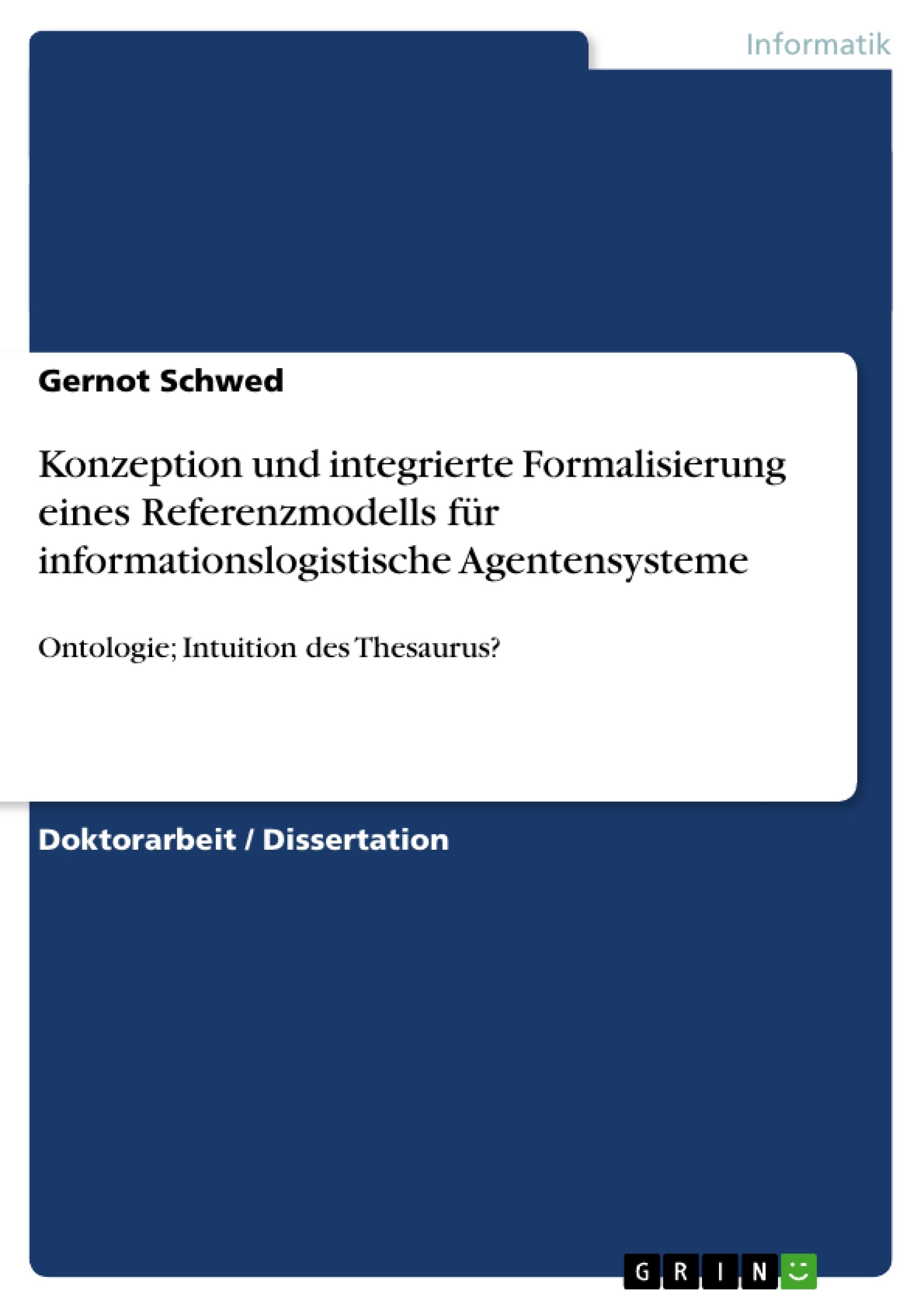Im sog. "Semantic Web" soll es Informations- und Koordinationssystemen möglich werden, miteinander zu kommunizieren, neue Wissensquellen über das Intra- bzw. Internet zu finden und dadurch komplexe Aufgaben selbständig lösen zu können. Dabei spielen Ontologien und Thesauri eine wichtige Rolle, um Inhalte objektorientiert zu spezifizieren sowie die Objekte und deren Beziehungen zueinander formal zu beschreiben.
Zielsetzung der Publikation ist die umfassende konzeptionelle Beschreibung eines informationslogistischen Agentensystems, das den Anforderungen heutiger (elektronischer) Märkte gerecht wird. Allgemein versteht man unter einem informationslogistischen Agentensystem die Realisierung einer Wissensbasis in Form eines Wissensmanagementinstrumentes mit Koordinationsfunktion, das fortlaufend betriebliches Wissen sammelt, aktualisiert, strukturiert und für verschiedene Aufgaben möglichst situationsbezogen und aktiv zur Verbesserung des kooperativen Arbeitens zur Verfügung stellt. Durch das Einschalten einer Forecast-Komponente zur synchronen Koordination des abteilungs- und unternehmensübergreifenden Wissens- und Workflow-Managements, wird ein Unternehmen in die Lage versetzt, nicht nur seine Leistungserstellung und Wertschöpfung zu optimieren sondern auch seine eigenen Kommunikationsabsichten und seinen eigenen Kommunikationsbedarf im Rahmen der Geschäftsprozessgestaltung, wie die bzw. den seiner Kooperationspartner, zu identifizieren.
Inhaltsverzeichnis
- Anforderung an die Publikation
- Ergebnis der Untersuchung
- Einleitung
- 1.0 Information
- 1.1 Kommunikation
- 1.2 Geschäftsprozess
- 1.2.1 Technologietransferprozess
- 1.2.2 Entscheidungsprozess
- 1.3 Virtualisierung
- 1.3.1 System
- 1.3.2 Kooperation
- 1.4 Informationslogistik
- 1.5 Nutzwert des Produktionsfaktors Wissen
- 2.0 Dokumentenmanagement
- 2.0.1 Information Retrieval
- 2.0.2 Relevanz
- 2.1 Dublin Core
- 2.2 Ontologie
- 2.3 Thesaurus
- 2.3.1 Semiotik
- 2.3.2 Semiotischer Thesaurusbegriff
- 2.4 Klassifizierung
- 3.0 Ontologische Modellierung
- 3.0.1 Gestaltung von Ontologien
- 3.0.2 Ontologische Modellierung mittels Thesauri
- 3.1 Knowledge Interchange Format
- 3.1.1 KIF-Formalisierung
- 3.1.2 Bildung von Axiomen mit dem KIF
- 3.2 Web Ontology Language
- 3.2.1 OWL-Formalisierung
- 3.2.2 Bildung von Axiomen mit der OWL
- 3.3 Simple Knowledge Organisation System
- 3.3.1 SKOS-Formalisierung
- 3.3.2 Bildung von Inferenzen mit dem SKOS
- 4.0 Fachkonzeptmodellierung
- 4.0.1 Informationsmodell
- 4.0.2 Meta-Modell
- 4.1 Informationsmodellmanagementsystem
- 4.2 Thesaurus-gestützte phonotaktische Forecast-Steuerung
- 4.2.1 Phonetik und Phonologie
- 4.2.2 Phonotaktik
- 4.2.3 Phonotaktische Modellierung
- 5.0 Zusammenfassung
- Entwicklung eines informationslogistischen Agentensystems als Referenzmodell
- Integration von Wissen und Information in Geschäftsprozessen
- Steuerung und Kontrolle von wissensbasierten Datawarehouse-Technologien
- Einsatz von Ontologien und Thesauri zur Modellierung von Fachkonzepten
- Anwendungen von Künstlicher Intelligenz in der Informationslogistik
- Anforderung an die Publikation: Diese Einleitung stellt das informationslogistische Agentensystem als zentrales Instrument zur Koordination von Geschäftsprozessen und deren Unterstützung vor. Es soll die Abstimmung der Wissenserwerbsstrategie über alle Unternehmensbereiche hinweg ermöglichen und dabei zunehmend auf selbsttätige Verfahren der Künstlichen Intelligenz setzen.
- Einleitung: Das Kapitel liefert eine grundlegende Einführung in die Thematik der Informationslogistik und erläutert den Zusammenhang von Information, Kommunikation, Geschäftsprozessen und Virtualisierung.
- Dokumentenmanagement: Dieses Kapitel befasst sich mit den Grundlagen des Dokumentenmanagements, insbesondere mit Information Retrieval, Relevanz und den Instrumenten Dublin Core, Ontologie und Thesaurus.
- Ontologische Modellierung: Hier werden die Konzepte und Methoden der ontologischen Modellierung vorgestellt, einschließlich der Verwendung von Ontologien und Thesauri. Es werden verschiedene Formalismen wie KIF, OWL und SKOS diskutiert.
- Fachkonzeptmodellierung: Dieses Kapitel konzentriert sich auf die Modellierung von Fachkonzepten mit Hilfe von Informationsmodellen und Meta-Modellen. Es beinhaltet auch eine Diskussion über Thesaurus-gestützte phonotaktische Forecast-Steuerung.
Zielsetzung und Themenschwerpunkte
Die Dissertation befasst sich mit der Konzeption und Formalisierung eines informationslogistischen Agentensystems als Referenzmodell. Dieses System soll den Anforderungen des modernen (elektronischen) Marktes gerecht werden und die Koordination von Geschäftsprozessen sowie deren Unterstützungsprozesse ermöglichen. Dabei wird ein integriertes Konzept zur Kontrolle und Steuerung von wissensbasierten Datawarehouse-Technologien vorgestellt. Das informationslogistische Agentensystem beinhaltet Funktionen zur zeitnahen Koordination von Mechanismen und Regelkreisen, die den Informations- und Kommunikationsbedürfnissen menschlicher und künstlicher Agenten in Problemlösungs- und Entscheidungssituationen dienen.
Zusammenfassung der Kapitel
Schlüsselwörter
Informationslogistik, Agentensystem, Datawarehouse, Ontologie, Thesaurus, Wissensmanagement, Geschäftsprozess, Technologietransfer, Künstliche Intelligenz, Information Retrieval, Formalisierung, Referenzmodell, Modellierung, Fachkonzept, Forecast-Steuerung.
- Quote paper
- Gernot Schwed (Author), 2007, Konzeption und integrierte Formalisierung eines Referenzmodells für informationslogistische Agentensysteme, Munich, GRIN Verlag, https://www.grin.com/document/85668



